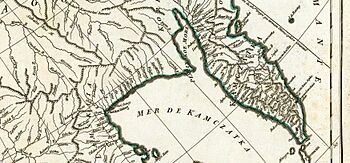Jean-Baptiste Bourguignon d'Anville facts for kids
Quick facts for kids
Jean-Baptiste Bourguignon d'Anville
|
|
|---|---|
 |
|
| Born | 11 July 1697 Paris, Kingdom of France
|
| Died | 28 January 1782 (aged 84) Paris, Kingdom of France
|
| Occupation | |
Jean-Baptiste Bourguignon d'Anville (born in Paris on July 11, 1697 – died January 28, 1782) was a famous French geographer and mapmaker. He made huge improvements to how maps were created. D'Anville became the king's official mapmaker. The king even bought his amazing collection of maps, which was the biggest in France!
D'Anville created over 200 maps during his life. These maps were known for being very careful and accurate. He based his work on real original research. Unlike older maps that often guessed, D'Anville left unknown areas blank. He also clearly marked any information that might not be certain. His maps were so good that they were used as the main reference for mapmaking throughout the 1800s. Many explorers and travelers relied on them.
Contents
Who Was Jean-Baptiste d'Anville?
Jean-Baptiste Bourguignon d'Anville was born in Paris, France, on July 11, 1697. From a very young age, he loved geography. When he was just twelve, he enjoyed drawing maps for Latin books. Later, his friend, a scholar named Abbé Longuerue, helped him a lot with his studies.
Early Career and Mapmaking Goals
D'Anville published his first serious map, which was of Ancient Greece, when he was only fifteen. By the age of twenty-two, he was named one of the king's geographers. Important people started to notice his talent. D'Anville studied everything about geography he could find in books. He looked at old and new history books, travel stories, and even poems and philosophy books.
One of his main goals was to make mapmaking better. He wanted to stop people from just copying old maps without checking them. He carefully checked the locations of places using all the information he could find. He also removed any names from maps that didn't have enough proof. This meant that large areas on maps that used to show many countries and cities suddenly became blank.
Mapping the World: China and Beyond
At first, d'Anville helped create maps for books by different travelers. He made an atlas for a book called "Description of China." This atlas was published in 1737. The information for these maps came from land surveys of the Chinese empire. These surveys were ordered by the Kangxi Emperor between 1708 and 1716. D'Anville's maps of China were considered the best Western source for China's geography for over a hundred years.
In 1743, d'Anville created a very successful map of Italy. This map showed many mistakes in earlier maps of the country. He also wrote a valuable report explaining where he got his information, which was a new idea for mapmakers. Later, a survey done in the papal states (parts of Italy ruled by the Pope) proved that d'Anville's map was very accurate.
In his later years, d'Anville did amazing work on maps of ancient and medieval times. He completely changed how people understood ancient geography. He re-mapped all the main countries of old civilizations, especially Egypt. He also wrote important books that made his work even more helpful to others.
His Amazing Map Collection
D'Anville spent his last years organizing his huge collection of maps, plans, and geographical materials. It was the largest collection in all of Europe! The king bought this collection, but he let d'Anville use it for the rest of his life. After finishing this big task, d'Anville became very weak in both mind and body. He passed away in January 1782.
Honors and Recognition
In 1754, when he was fifty-seven, d'Anville became a member of the Académie des Inscriptions et Belles Lettres. He wrote many papers for this important group. In 1773, he joined the Académie des Sciences as an assistant geographer. In the same year, he was named the first geographer to the king. He was also a member of the Society of Antiquaries of London and the Russian Academy of Sciences.
A street in the 14th arrondissement of Paris was named after him 82 years after his death. A statue of him was placed on the city's Hotel de Ville (City Hall) in 1881.
Even a crater on the Moon is named after him, called Anville. The community of Danville, Vermont in the United States is also named in his honor.
Images for kids





